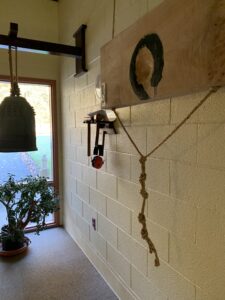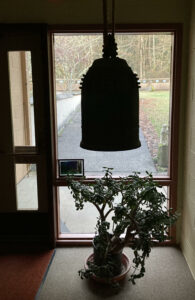TimeKeeper Diaries, part 3

In this final installment from the TImekeeper Diaries, I’d like to provide the reader with a few final choice glimpses from the Timekeeper’s seat. There are lines of silent communication, and details that emerge in stillness.
Before I get there, though, one early foggy morning as I walk from my room to the cafeteria, I hear in the distance the deep call of a fog horn sounding from the Columbia River below. There is solace in knowing that I’m not the only one awake at 3:30 am and I’m not the only one who is about to disturb the morning’s fog-blanketed quiet. While we maintain noble silence and are enjoined not to write during sesshin, I make a note and hang it up on my wall.

Later, han sounded and incense offered, seated in the front of the zendo behind the altar and the shusso’s seat, I am able to see what others may not. These views include the sleepy, somnolent sitters doing their mightiest to thwart the siren song of sleep at any time of day, but especially when the shusso sets the overhead zendo lights to the “NAP” setting. Another touching sight is that of a practitioner, evidently in pain, persisting in sitting still through to the longed-for bell. As a testament to the knowledge of the body, when folks finally concede to standing on their zabuton, it often occurs only moments before the bell is to sound.
Another memorable view from the Timekeeper’s seat occurs during our closing chant, as the assembled all give voice to “Shantideva’s Way of the Bodhisattva.” During this sesshin, the seating chart has Jikai seated next to Myoyu, both devoted practitioners and chanters. I am reminded of Raphael’s cherubim in the Sistine Chapel. At the close of a long day of sitting, breathing, sitting, and breathing again, they both chant with particular enthusiasm, as they move and sway to the same sound, not two, with eyes closed and chins lifted, seemingly aware only of the beauty of Shantideva’s Way, all our voices raised in unison, and this one moment in time. The sight is so lovely I am brought to tears while I chant in my bell-clad corner.
A perhaps less lovely sight started with a sound, at first unidentifiable. I sensed and heard a what? a scurrying? across the back of the Timekeeper zabuton. Surely, a small creature–a mole, perhaps out for a rare daylight scamper alongside the building? And then I heard the sound again and turned toward the altar to see the second mouse, clad in his furry winter coat, join his companion at the mouth of the opening to the wooden cord cover.
 Hmm…perhaps these are refugees from the construction that’s been occurring in the han bathroom. I look over at Gensei, the shusso, who has seen and heard with me the little winter-coated visitors. After the period, we confer in whispers beginning with Gensei asking, “How do you feel about mice?”
Hmm…perhaps these are refugees from the construction that’s been occurring in the han bathroom. I look over at Gensei, the shusso, who has seen and heard with me the little winter-coated visitors. After the period, we confer in whispers beginning with Gensei asking, “How do you feel about mice?”
As I write this, the densho sounds. I am reminded that during sesshin, when we only use the han, I missed ringing it. Outside of sesshin, the densho signals the beginning of service, and I get to clang it a lot. It is a large metal hanging bell with a lovely view of the woods. I aim for the small flat target when I strike it with a wooden mallet.
Like all of the bells, it marks beginnings and endings.
And today, just a few hours ago, we chanted the Jizo Shingon while we processed in our zendo garb to the Jizo Maple where Onshin offered incense and we chanted again, this time the Dai Shin Dharani, the dharani of the Great Compassionate One. Ed was King of the Inkan (the small but remarkably loud portable bell) and Jikai kept us organized on the way with the drum. From there, we gathered indoors and ceremonially ended this 60-day period of Ango by wishing one another “blessings and support on this endless path.” May it be so.
